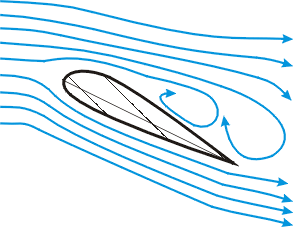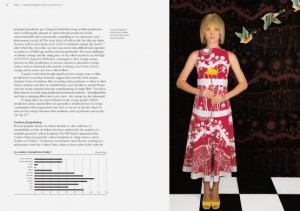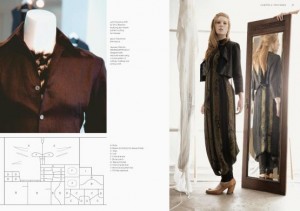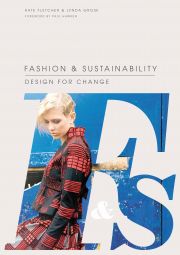Fashion & Sustainability – Design for Change
By: Kate Fletcher, Lynda Grose
ISBN: 9781856697545
The conundrum with sustainable fashion is, that there are numerous ideas flying about. Some of them are of the practical type – small, medium and large businesses trying out practical ways of how to make it work -, others of the academic variety. With Fashion & Sustainability, Kate Fletcher and Lynda Grose have done a thorough job in pulling all these ideas and approaches together from a designer’s perspective, and organise them in a coherent, logic trail where concept is married with practise.
In many ways, this book continues where Kate Fletcher’s first book, ‘Sustainable Fashion & Textiles – Design Journeys’, left off. But rather than ‘just’ repeating the content in different words, with updated concepts and additional examples, the book is indeed a worthy successor and expands the reach of its arguments into all areas in fashion production where design – or rather: the (product) designer – is of relevance.
Like in the first book, the authors start at the beginning of the fibre life cycle, although without duplicating content, but rather expanding and deepening the insights gained previously. While this initial section of the book is compulsory, and it can’t be done without, the further towards the book one progresses with reading, the more essence, food for thought and new ideas and conclusions come up.
Strategically hence, the book is very well organised: it starts slowly with a certain amount of repetition to prepare the ground and make sure that every one among the readers is on the same page, has the same fundamental understanding of what we’re at, and what the problems and first off, intuitive approaches are.

The book is divided into 3 parts, with five, nine and four chapters respectively.
– Part one is dedicated to the actual process stages of the fashion production system.
– Part two investigates new, novel or future models that will in one way or another impact the reality of the ‘fashion business standard model’ as outlined in the first part.
– And part three focuses again entirely on the role of the designer, and the opportunities designers have to be ‘at the lever’ of the fashion system and facilitating change.
In this way, the book is ‘shaped’ like the cross section of an air plane wing: narrow and with a broad take up at the beginning, wide in the middle allowing the material to develop traction, and very focused, targeted and with a clear message again towards the end.
But in more detail – what does the book cover, and how?

As mentioned above, the first part of the book is dedicated to the actual process stages of the fashion production system. It starts off with fibre creation and ends with discussing waste. Importantly however, the chapters address the topic differently then what we have seen in Fletcher’s first book – organised this time around the different challenges that arise, an approach consistently pursued also in the following chapters about production, transport and waste. There are a couple of usually only rarely discussed topics tackled as well: predator friendly fibres as an example.
In essence, part one lays the ground work of the state of the art, predominant challenges, possibilities for mitigation (such as ecology of dye baths, zero-waste pattern cutting or upcycling), and in this presents a consolidated picture of the current state-of-the-art.
Part two then tackles systemic issues from a designer’s perspective: Every chapter lists a key technical, operational or conceptual requirement to be implemented in the fashion process for the whole bigger picture moving towards a ‘better whole’. It is important to say here, that these chapters are indeed written first and foremost from the perspective of a designers, and very clearly also target fashion designers as addressees.
Topics tackled are: adaptability of garments to varying uses and utilisation patterns; emotional durability of designs and how (not) to achieve it; design based optimisations that affect the usage phase, specifically laundry; sharing and mending of garments, including how to make it easier for people to be able and mend their clothes; the paradoxes of producing local (i.e. just bringing production back isn’t the solution to the problem …), including a redefinition of what ‘local’ and ‘local skills’ may mean; the concept of biomimicry on a technological (fabric, fibre) level, but also on a conceptual (usability) level; the complementary role of ‘fast’ and ‘slow’ fashion; and finally the engagement with the end user either by designing for their usage needs, or by co-creating, in either case enhancing the long-term ‘survival’ of a garment in a wardrobe.
The third and last part finally, aims at encouraging designers to truly engage with what they design, as well as with for whom they design. This part therefore introduces us to ideas such as fashion design as educational medium, as grass roots activism, as awareness and skills facilitator, and – importantly – as an entrepreneurial approach promoting alternative business models (and in that sense: a different type of grass roots activism).
In summary:

The book is a pleasure to read as an expert, as a student, and even only as an ‘interested outsider’.
Across the full length there are numerous details, insights and facts that are, if not unknown even to people from within the world of sustainability in fashion, at the very least presented in a way and context that invites to further reflection.
The voice, presentation and logic of the book, make it equally a compelling read for students who need to get a firm grounding on the challenges, as well as the ‘merely’ interested reader who just wants a basic, but relevant, introduction to the issues the fashion industry encounters.
The style overall is a well achieved balance between academic thoroughness in research, and hands on examples relevant to those working in the industry. There is plenty of information that is relevant and appealing to professionals active in various specialities in the fashion industry. But the book excels in what it offers for its target audience of designer practitioner, of both small and large brands: Examples and case studies are as a consequence extremely well chosen, to a degree that they will get the message across without failure and in the concise and tangible way. A practising designer will only need to translated it – with all that is required being nearly a 1:1 methodical copy – into practise.
One could argue that the book falls short of presenting the often talked about, never detailed but dearly needed ‘alternative business models’. This argument is, in a sense, accurate. And at the same time it is not. Being a book primarily taking a designer’s perspective, and targeting the fashion community clearly from that angle, there are numerous indicators that when thought through, the presented material cannot be put into practise unless business models change. To build economic models, management case studies around these pointers, however, should certainly not be within the scope of this book.
In other words: Not only does the book document the state-of-the-art as we encounter it in the present, but for the first time designers have both: a hands on manual of how they can take charge of and change their practise, and what new concepts and technologies at their disposal will be in the near to mid-term future.
Fashion & Sustainability is a worthy, rounded, well researched and well written successor to Kate Fletcher’s first book. And as such it no doubt merits some of the scarce space available on our book shelf.
—
This book is available from your nearest book store as well as online from Amazon.


